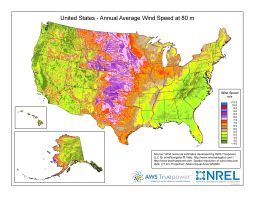Wind Maps
NREL's Geographic Information System (GIS) team offers both a national wind resource assessment of the United States and high-resolution wind data. The national wind resource assessment was created for the U.S. Department of Energy in 1986 by the Pacific Northwest Laboratory and is documented in the Wind Energy Resource Atlas of the United States, October 1986. This national wind resource data provides an estimate of the annual average wind resource for the conterminous United States, with a resolution of 1/3 degree of latitude by 1/4 degree of longitude.
The wind resource assessment was based on surface wind data, coastal marine area data, and upper-air data, where applicable. In data-sparse areas, three qualitative indicators of wind speed or power were used when applicable: topographic/meteorological indicators (e.g. gorges, mountain summits, sheltered valleys); wind deformed vegetation; and eolian landforms (e.g. playas, sand dunes). The data was evaluated at a regional level to produce 12 regional wind resource assessments; the regional assessments were then incorporated into the national wind resource assessment.
The conterminous United States was divided into grid cells 1/4 degree of latitude by 1/3 degree of longitude. Each grid cell was assigned a wind power class ranging from 1 to 6, with 6 being the windiest. The wind power density limits for each wind power class are shown in Table 1-1. Each grid cell contains sites of varying power class. The assigned wind power class is representative of the range of wind power densities likely to occur at exposed sites within the grid cell. Hilltops, ridge crests, mountain summits, large clearings, and other locations free of local obstruction to the wind will be well exposed to the wind. In contrast, locations in narrow valleys and canyons, downwind of hills or obstructions, or in forested or urban areas are likely to have poor wind exposure.
 |
 |
 |
 |
 |
U.S. Annual Average Wind Speed at 30m Map
This map shows national 30m wind speed potential for the United States. State maps are available at the Wind Powering America website.
- Low Resolution - JPG 622 KB
U.S. 80m Wind Resource Maps
This map shows national 80m wind resource potential for the United States.
- Low Resolution - JPG 4.0 MB
This map shows national 80m land-based and offshore annual wind resource potential for the United States.
- Low Resolution - JPG 2.12 MB
Additional 80m maps using higher resolution data are available at the Wind Powering America and U.S. DOE EERE websites.
U.S. 90m Offshore Wind Resource Map
This map shows 90m offshore wind resource potential for the United States.
- Low Resolution - JPG 70 KB
U.S. 50m Wind Resource Map
This map shows national 50m wind resource potential for the United States.
- Low Resolution - JPG 142 KB
- High Resolution - PDF 2.5 MB
For more wind resource maps, access the MapSearch site.
For information on how these maps were developed, access the GIS Data Background page.
For Geographic Information System (GIS) wind resource data, access the Data Resources page.
For interactive maps and tools for viewing maps and data, access the Data Visualization and Tools page.
If you have difficulty accessing these maps because of a disability, please contact the Webmaster.










